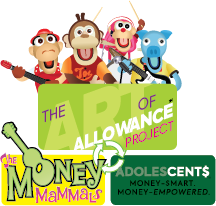
“Working to help parents raise money-smart kids.”
Hello again!
For this week’s Money-Smart Monday newsletter, I’m thinking about the power of allowance.
I want to share two perspectives on the power of allowance: It can help you more easily say “no,” and it can help you teach values that are important to you and your family.
I’ll then get more practical and share two easy ways you can get started with your own allowance program.
— 1 —
The Power of “No”: First up is recent podcast guest Ellen Rogin. In this short video from our longer conversation, Ellen shares a key benefit of an allowance — it helped her to say “no” to her kids’ requests. Kids are prone to constant petitioning, so turning over monetary control to them gives them skin in the game. An allowance provides them with a fairly minimal source of money which they can spend, and they learn to make choices in the process. It also moves you from proxy decision maker to adviser, which, by definition, makes you more helpful to them. Kids quickly realize after a few “no” responses to requests for things they want that you will no longer dole out additional money, that they have agency and that their decisions matter.
— 2 —
Allowance and Values: My conversation with Brad Klontz was enlightening. He not only shared some wisdom for the ages — take any personal advice with a grain of salt, something readers of this newsletter should consider as well — but also provided another big benefit of setting up an allowance. It can be used to teach our kids values we want to impart on them. And though we may not always be successful in instilling our values in our kids, we should certainly be intentional about our efforts.
Along these lines, I’ve often been asked if talking to kids about money from a young age sullies their childhoods. My response usually takes this form: If you aren’t prepared to have conversations about money with your kids and to answer their questions, then they will seek advice elsewhere. From their friends. From the media. Basically, from random, uncontrolled sources. Why wouldn’t you want to be the source? You certainly have thoughts on the subject you’d like to share with them.
— 3 —
Getting Started: Finally, I’d like to share two ways you can set up an allowance for your kids today. In the Parents section of The Art of Allowance Project, you can establish a simple, “starter” allowance for younger kids with The Allowance Kickstarter. Think of this like a mini contract you draw up to put your kids on the road to money smarts. There are directions to help you set up the three jars, decide on the amount of money you’ll provide and outline a few simple rules. Importantly, this is intended to be updated and improved as you learn what works and what doesn’t with your child.
If you have older kids or are looking to move beyond a starter allowance, then give The Breakthrough Allowance a try. We provide a downloadable Google Sheet that you can use to set up an allowance for your tweens or teens that will give them more money (and thus more responsibility) to spend on things like clothing, food out with friends, gifts and phone charges. For many parents, the teen years can feel like someone’s attached a vacuum to their wallets. The Breakthrough Allowance transfers control of much of this spending to your kids. I think you’ll discover what we did — kids are much more responsible with their own money than they are with yours.
Of course, as always, please consult with a financial or investment professional before engaging in any decisions that might affect your own financial well-being.
Until next week, enjoy the journey.
John, The Chief Mammal
Like what you just read? You can sign up for the newsletter here.

